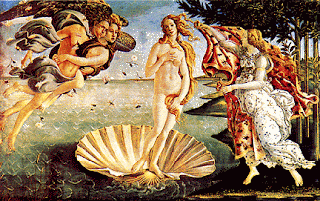1. Briefly describe the medium used, the genre to which the ‘text’ belongs and the context in which it was found.
The text is an Indoor graffiti artwork of Banksy- a well-known pseudo-anonymous English graffiti artist. He is believed to be a native of Yate, South Gloucestershire, near Bristol and born in 1974, but there is substantial public uncertainty about his identity and personal and biographical details
The text depicted a combination of fictional characters (Mickey mouse and McDonal’s clown) and real person (the little girl)
2. Why did you choose this ‘text’?
How does the ‘text’ relate to your own values?
I choose this text because I like what Banksy does, he brought street graffiti to a higher level and considered, recognised by public, government bodies as and actually some of his outdoor graffiti is protected against invasion.
This “text”, together with other “texts” from him containing a deep insight, expresses his philosophy, vision about life and all the things around him. I especially like this ‘text’ because of the creativeness he has put in it. With the Mickey Mouse and the Clown, the first impression we might have is some kind of happiness because of this two characters, but soon when look at the little girl in the middle, I recognised that happiness was not Banksy first intention while creating this text, especially I have seen the picture of this girl long time ago and it’s a part of Vietnam-America war’s history, where I come from…it’s world well known and named Vietnam Napalm, taken by photographer Nick Ut in 6/8/1972, in TRANG BANG Vietnam.

That is also the reason why I have such a strong feeling for this ‘text’, was born and grow up in Vietnam 8 years after the war ended, I know how miserable and tragedy a war could affect every person’s life. Then, I told my self I will try my best to help others, be responsible and respect each other...that I believe will make life better. This ‘text’ appeals to me with two different meaning (1) since the Mickey mouse and the clown are from America, I wondering is Banksy made this ironically targeting America or not (2) These characters also represent happiness for the children, and they are holding the little girl’s hands and walk her out of the past…Isn’t it nice?
3. What reality claims are made by the ‘text?’
War is bad and we should together make life better with all its meaning or children deserve happiness.
4. Does it allude to being fact or fiction?
I think it’s both, fact and fiction…In my opinion; this is always Banksy’s unique style of creating his texts
5. How might a change of medium affect the meanings generated?
I think if there is a change of medium, this will affect the meanings of the text...By using two colours black, white and graffiti-way to express this ‘text’, he want this to be acknowledge as a strong, simple artwork which will stay in their mind and make them think, rather than an striking painting then fade away
6. Describe the paradigm sets used (such as shot size: long shot, mid shot, close up). Why have you used this particular shot and not a different one?
The paradigm sets used is mid shot to capture all of the three characters and put them into the focus point, in which the central focus is the little girl.
It’s interesting that in the original photo “Vietnam napalm”, the girl was also captured in the central focus, also using mid-shot technique. By that, we can also have the overview about the background and the situation when the photo was taken.
7. How might a change of shot size affect the meanings generated?
I think if we change a shot size, meaning from mid-shot to long-shot or close up, we will limit and decrease the impact of the text to audiences.
8. How does the sequential or spatial arrangement of the elements influence meaning?
The only arrangement with the text here is the position of each character. If we change their position, push them backward or move them forward; the meaning of the text will be changed and doesn’t transfer the right message to audiences as it supposes to. For example, if we move the girl to the right hand side or left hand side, audience will loose their concentrate for her, instead of her, the focus now will be moved to Mickey mouse or the Clown, which I believe certainly is not what Bansy intend to create.
9. What relationships does the ‘text’ seek to establish with its readers?
In my opinion, the “text” is definitely constructing relationship with its readers. To the readers who already the story behind, it encourage them to think further about what they are having in life and what should they do to make things better in a good way. For those who are happening not to know the story, this I think will strike them with some question such as: who is that girl, why would she cry, why, why… These questions will encourage them to find the answer and soon lead them to the first situation. Therefore, the relationship between the text is a positive one, the text will not only lead readers to discover more about the text itself but also help them to cherish more what they have.
10. How direct is the mode of address and what is the significance of this?
In this case, I will say it is very direct, from the straight angle to the clear background, the colour back and white…very clear, direct and constructive.
11. What insights has a semiotic analysis of this ‘text’ offered?
From what I have perceived, this text has done its best job. It constructed deep meaning toward readers, made them think and lead them to gain their own perception about the text and the whole story about it. It also enables Banksy to once again, set his tone in the art of street graffiti.










